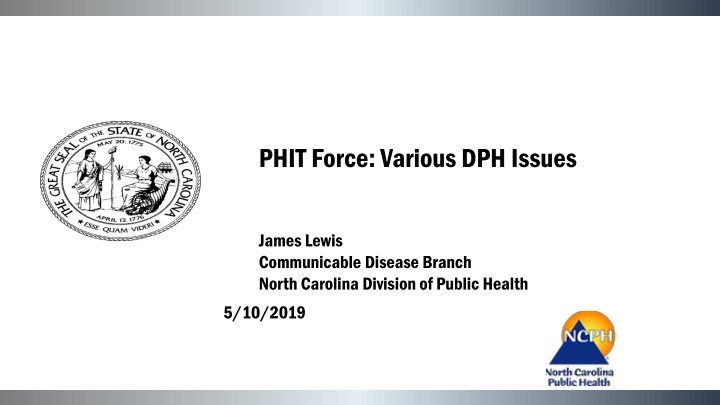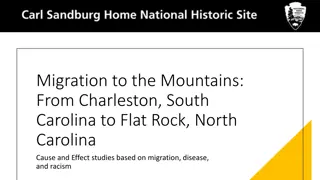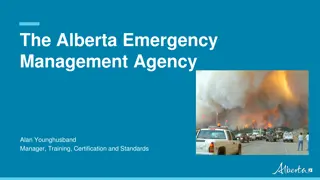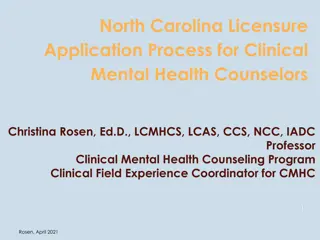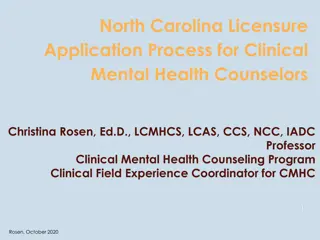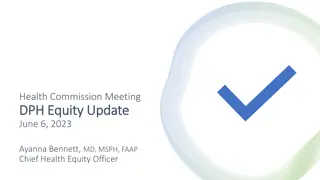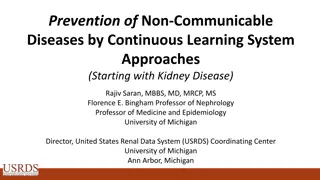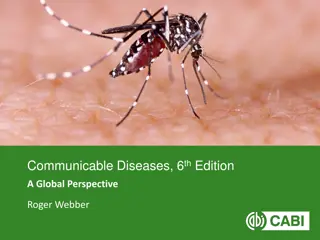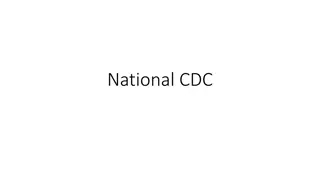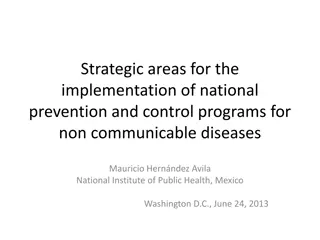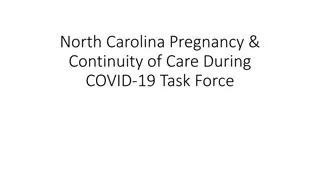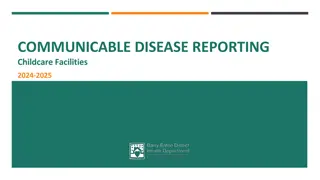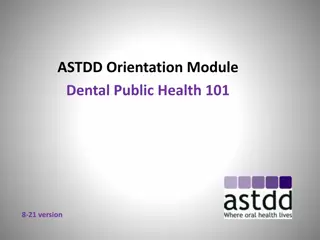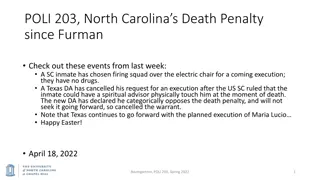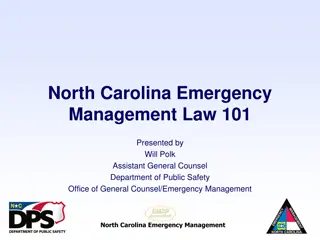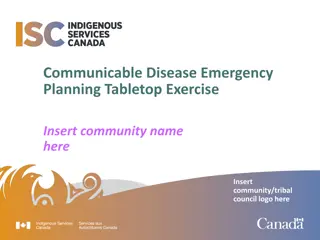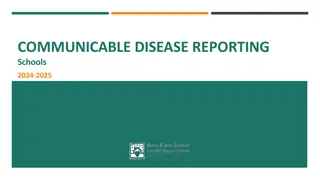PHITForce: Various DPH Issues - Communicable Disease Branch North Carolina Division of Public Health
In this overview, topics such as C.auris/CRE screening, Candida identification, Expanded AST availability, CRE Surveillance update, and antibiotic use reporting are discussed, along with details on Travel screening for Ebola and Measles. ARLN Services cover a range of screenings, including C.auris/CRE screening, Candida speciation, and Expanded AST testing. The CRE Surveillance in North Carolina involves targeted recruitment for sentinel surveillance, special projects, and outbreak response, with specific periods of surveillance identified. Exclusions for duplicate CRE cases are also mentioned.
Download Presentation

Please find below an Image/Link to download the presentation.
The content on the website is provided AS IS for your information and personal use only. It may not be sold, licensed, or shared on other websites without obtaining consent from the author.If you encounter any issues during the download, it is possible that the publisher has removed the file from their server.
You are allowed to download the files provided on this website for personal or commercial use, subject to the condition that they are used lawfully. All files are the property of their respective owners.
The content on the website is provided AS IS for your information and personal use only. It may not be sold, licensed, or shared on other websites without obtaining consent from the author.
E N D
Presentation Transcript
PHITForce: Various DPHIssues James Lewis Communicable Disease Branch North Carolina Division of Public Health 5/10/2019
Overview C auris/CRE screening Candida identification Expanded AST available through ARLN CRE Surveillance update SIR calculation error on CDC website Antibiotic use reporting potential requirement Travel screening: Ebola and Measles
ARLN Services: C auris/CRE screening Outbreak/Sentinel event Roommate Point Prevalence Travel: Overnight Healthcare outside US CRE screening:Cepheid PCR on rectal swabs Double tipped, rayon/Eswab compatible with Cepheid https://health.maryland.gov/laboratories/Pages/ARLNHome.aspx#CRE C auris screening: PCR on composite axillary/groin swab Rayon tipped/nylon flocked swab https://www.cdc.gov/fungal/candida-auris/recommendations.html https://health.maryland.gov/laboratories/Pages/ARLNHome.aspx#CRE
ARLN Services: Candida speciation Commonly misidentified candida: https://www.cdc.gov/fungal/candida-auris/recommendations.html
ARLN Services: Expanded AST testing Hewlett-Packard D300e printer pilot project https://www.cdc.gov/drugresistance/solutions-initiative/innovative-hp-resistance- testing.html Can test novel drug combinations (i.e. aztreonam-avibactam) Year long project 4 labs Tennessee State Public Health Laboratory, Wisconsin State Laboratory of Hygiene, Minnesota Department of Health Public Health Laboratory, and Wadsworth Center Laboratories ARLN/DPH gate keepers Goal 3 day turn around from day of request Pan-resistant MBLs (NDM/IMP/VIM)
Surveillance in NC Targeted recruitment for sentinel surveillance, special projects and outbreak response Sentinel site surveillance July 2017 September 2018 Mar. 2015 Sep. 2016 Nov. 2016 June 2017 October 2018 Present Reportable, routine surveillance statewide, special projects and outbreak response Accepted isolates, no active site recruitment 8
*Excludes duplicate CRE (Same Carbapenemase/organism; repeat clinical isolates in a 12 month period; screening results subsequent to a clinical result) 9
Sentinel Surveillance 57% 57% of reported CRE reported to NC DPH of reported CRE reported to NC DPH are carbapenemase producing are carbapenemase producing 10
Sentinel Surveillance ~10 CRE per ~10 CRE per month month 11
Sentinel Surveillance OXA-48 18.45% KPC 76.70% IMP 3.88% NDM <1% 12
CRE Surveillance Since October 1, 2018 Updated: February 8, 2019 13
52% of isolates submitted to the state 52% of isolates submitted to the state lab are CP lab are CP- -CRE CRE 97% KPC 0.9% NDM 1.9% OXA-48 14
Surveillance ~50 CRE per ~50 CRE per month month 15
Epi Curve of Carbapenemase Detection since October 1, 2018 70 60 50 Number of Isolates 40 30 20 10 0 October November December January February March April Negative KPC NDM OXA VIM IMI OXA/NDM 16
Carbapenemase by Organism Other E. coli Enterobacter Klebsiella 0 20 40 60 80 100 120 140 160 180 Number of Isolates KPC NDM OXA OXA/NDM Negative OXA/NDM VIM IMI 17
As of 2019, NC has seen all 5 carbapenemases 2.5% 0.8% 0.3% 0.1% 49% 18
NHSN SIR Calculation error https://gis.cdc.gov/grasp/PSA/HAIreport.html
NHSN SIR Calculation error Correct calulation: ( National SIR NC SIR )/National SIR = (0.81-0.98)/0.81 = 0.21 0.40 CDC Calulation: National SIR NC SIR/National SIR Order of operations = multiplication, division, addition, subtraction So this comes to 0.81 0.98/0.81 = 0.81 1.21 = 0.40 In short I assume someone forgot to add parentheses in their coding Being addressed Same across all states 2016 & 2017 numbers CLABSI Only
Antibiotic Use reporting What information did you hear? No active pursuance of AU reporting in NC at this time Will likely be required at some point but a requirement is likely at least 3 years out I would imagine BUT Its strongly encouraged Ideally would be through NHSN AUR module https://www.cdc.gov/nhsn/acute-care-hospital/aur/index.html
Antibiotic Use reporting From QIN-QIO National LAN Event 5/9/19 Asked about national requirement We will see what happens We would like to pursue a State requirement like MO/TN
Travel Screening: Ebola and measles Should hospitals consider heightened surveillance for measles and Ebola (e.g., travel to an endemic state or country-Congo)? We continue to suggest that hospitals ask about travel history, regardless of circulating or emerging diseases as this can be useful in forming differential diagnoses, determining need for pre-emptive isolation precautions or screening, etc. At the moment, we are not suggesting that hospitals ask specifically about measles or Ebola exposure, but these outbreaks do highlight the importance of ongoing travel screening. Thus far, the ongoing Ebola outbreak in DRC has been identified as posing high risk regionally but a low risk globally. As I m sure you are, we are carefully monitoring the situation and will revise recommendations as needed. Since the beginning of the year, we have been working with one NGO to repatriate HCWs providing care in the Ebola-affected areas of DRC. We have worked specifically with this NGO and partners to coordinate care if needed. To date, all returning travelers have been classified as having no known risk of exposure to Ebola.
Travel Screening: Ebola and measles Ebola and patient triage - would a patient with symptoms and travel history suspicious of Ebola in NC go to the closest hospital for care or to an identified health care facilities with unique capabilities for managing the patient (if so, where)? The Healthcare Preparedness Program within OEMS is working with 8 major medical centers (regional trauma centers) to assure preparation and ability to provide care as an Ebola Assessment Center. It is our expectation that patients with concerning symptoms and potential exposure to Ebola would be routed to one of these facilities for initial assessment if at all possible.
Travel Screening: Ebola and measles Summary: Maintain situational awareness If a case presents concerning for measles or Ebola we would appreciate a call and will be of assistance 919-733-3419 Epidemiologist on call 24/7 Concerning patients would ideally be routed to one of the 8 regional trauma centers. If needed can likely arrange for transfer from there to Emory or NIH for further treatment. Ideally would be aware ahead of time and direct patients to care with pre-notification of the facility, but not always possible.
Questions? James Lewis James.w.lewis@dhhs.nc.gov 919-546-1641
